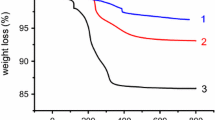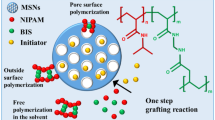Abstract
Silica nanoparticles (NSiO2) are modified with mixed polymer brushes derived from a block copolymer precursor, poly(methyl methacrylate)-b-poly(glycidyl methacrylate)-b-poly(tert-butyl methacrylate) with short middle segment of PGMA, through one step “grafting-onto” approach. The block polymer precursors are prepared via reversible addition–fragmentation chain transfer-based polymerization of methyl methacrylate, glycidyl methacrylate, and tert-butyl methacrylate. The grafting is achieved by the reaction of epoxy group in short PGMA segment with silanol functionality of silica. After hydrolysis of poly(tert-butyl methacrylate) segment, amphiphilic NSiO2 with “V-shaped” polymer brushes possessing exact 1:1 molar ratio of different arms were prepared. The functionalized particles self-assemble at oil/water interfaces to form stable large droplets with average diameter ranging from 0.15 ± 0.06 to 2.6 ± 0.75 mm. The amphiphilicity of the particles can be finely tuned by changing the relative lengths of poly(methyl methacrylate) and poly(methacrylic acid) segments, resulting in different assembly behavior. The method may serve as a general way to control the surface property of the particles.











Similar content being viewed by others
References
Pickering SU (1907) Emulsions. J Chem Soc 91:2001–2021
Tambe DE, Sharma MM (1994) The effect of colloidal particles on fluid-fluid interfacial properties and emulsion stability. Adv Colloid Interface Sci 52:1–63
Aveyard R, Binks BP, Clint JH (2003) Emulsions stabilised solely by colloidal particles. Adv Colloid Interface Sci 100–102:503–546
Binks BP, Lumsdon SO (2000) Catastrophic phase inversion of water-in-oil emulsions stabilized by hydrophobic silica. Langmuir 16:2539–2547
Lin Y, Skaff H, Emrick T, Dinsmore AD, Russell TP (2003) Nanoparticle assembly and transport at liquid–liquid interfaces. Science 299:226–229
Binks BP, Lumsdon SO (2000) Influence of particle wettability on the type and stability of surfactant-free emulsions. Langmuir 16:8622–8631
Binks BP (2002) Particles as surfactants—similarities and differences. Curr Opin Colloid Interface Sci 7:21–24
Horozov TS, Binks BP (2006) Particle-stabilized emulsions: a bilayer or a bridging monolayer. Angew Chem Int Ed 45:773–776
Frelichowska J, Bolzinger MA, Pelletier J, Valour JP, Chevalier Y (2009) Topical delivery of lipophilic drugs from o/w Pickering emulsions. Int J Pharm 371:56–63
Dinsmore AD, Hsu MF, Nikolaides MG, Marquez M, Bausch AR, Weitz DA (2002) Colloidosomes: selectively permeable capsules composed of colloidal particles. Science 298:1006–1009
Simovic S, Prestidge CA (2007) Nanoparticle layers controlling drug release from emulsions. Eur J Pharm Biopharm 67:39–47
Menner A, Ikem V, Salgueiro M, Shaffer MSP, Bismarck A (2007) High internal phase emulsion templates solely stabilised by functionalised titania nanoparticles. Chem Commun 41:4274–4276
Binks BP (2002) Macroporous silica from solid-stabilized emulsion templates. Adv Mater 14:1824–1827
Biswas S, Drzal LT (2009) A novel approach to create a highly ordered monolayer film of graphene nanosheets at the liquid-liquid interface. Nano Lett 9:167–172
Binks BP, Rodrigues JA (2007) Double inversion of emulsions by using nanoparticles and a di-chain surfactant. Angew Chem Int Ed 46:5389–5392
Binks BP, Whitby CP (2004) Silica particle-stabilized emulsions of silicone oil and water: aspects of emulsification. Langmuir 20:1130–1137
Binks BP, Rodrigues JA (2007) Synergistic interaction in emulsions stabilized by a mixture of silica nanoparticles and cationic surfactant. Langmuir 23:3626–3636
Binks BP, Rodrigues JA (2007) Enhanced stabilization of emulsions due to surfactant-induced nanoparticle flocculation. Langmuir 23:7436–7439
Duan H, Wang D, Sobal NS, Giersig M, Kurth DG, Möhwald H (2005) Magnetic colloidosomes derived from nanoparticle interfacial self-assembly. Nano Lett 5:949–952
Kim B, Tripp SL, Wei A (2001) Self-organization of large gold nanoparticle arrays. J Am Chem Soc 123:7955–7956
Duan H, Wang D, Kurth DG, Möhwald H (2004) Directing self-assembly of nanoparticles at water/oil interfaces. Angew Chem Int Ed 43:5639–5642
Li Y, Huang W, Sun S (2006) A universal approach for the self-assembly of hydrophilic nanoparticles into ordered monolayer films at a toluene/water interface. Angew Chem Int Ed 45:2537–2539
He J, Zhang Q, Gupta S, Emrick T, Russell TP, Thiyagarajan P (2007) Drying droplets: a window into the behavior of nanorods at interfaces. Small 3:1214–1217
Cheng JL, He JP, Li CC, Yang YL (2008) Facile approach to functionalize nanodiamond particles with V-shaped polymer brushes. Chem Mater 20:4224–4230
Binks BP, Ashby NP (2000) Pickering emulsions stabilised by Laponite clay particles. Phys Chem Chem Phys 2:5640–5646
Amalvy JI, Armes SP, Binks BP, Rodrigues JA, Unali GF (2003) Use of sterically-stabilised polystyrene latex particles as a pH-responsive particulate emulsifier to prepare surfactant-free oil-in-water emulsions. Chem Commun 15:1826–1827
Binks BP, Rodrigues JA (2005) Inversion of emulsions stabilized solely by ionizable nanoparticles. Angew Chem Int Ed 44:441–444
Binks BP, Murakami R, Armes SP, Fujii S (2005) Temperature-induced inversion of nanoparticle-stabilized emulsions. Angew Chem Int Ed 44:4795–4798
Binks BP, Rocher A (2009) Effects of temperature on water-in-oil emulsions stabilised solely by wax microparticles. J Colloid Interface Sci 335:94–104
He J, Niu Z, Tangirala R, Wang J, Wei X, Kaur G, Wang Q, Jutz G, Boker A, Lee B, Pingali SV, Thiyagarajan P, Emrick T, Russell TP (2009) Self-assembly of tobacco mosaic virus at oil/water interfaces. Langmuir 25:4979–4987
Binks BP, Clint JH (2002) Solid wettability from surface energy components: relevance to Pickering emulsions. Langmuir 18:1270–1273
Binks BP, Lumsdon SO (2000) Effects of oil type and aqueous phase composition on oil–water mixtures containing particles of intermediate hydrophobicity. Phys Chem Chem Phys 2:2959–2967
Barbey R, Lavanant L, Paripovic D, Schüwer N, Sugnaux C, Tugulu S, Klok HA (2009) Polymer brushes via surface-initiated controlled radical polymerization: synthesis, characterization, properties, and applications. Chem Rev 109:5437–5527
Zhao B, Brittain WJ (2000) Polymer brushes: surface-immobilized macromolecules. Prog Polym Sci 25:677–710
Zhao B, Zhu L (2009) Mixed polymer brush-grafted particles: a new class of environmentally responsive nanostructured materials. Macromolecules 42:9369–9383
Mansky P, Liu Y, Huang E, Russell TP, Hawker C (1997) Controlling polymer–surface interactions with random copolymer brushes. Science 275:1458–1460
Wuelfing WP, Gross SM, Miles DT, Murray RW (1998) Nanometer gold clusters protected by surface-bound monolayers of thiolated poly(ethylene glycol) polymer electrolyte. J Am Chem Soc 120:12696–12697
Corbierre MK, Cameron NS, Lennox RB (2004) Polymer-stabilized gold nanoparticles with high grafting densities. Langmuir 20:2867–2873
Hong CY, You YZ, Wu DC, Liu Y, Pan CY (2005) Multiwalled carbon nanotubes grafted with hyperbranched polymer shell via SCVP. Macromolecules 38:2606–2611
Li X, Hong C, Pan C (2010) Preparation and characterization of hyperbranched polymer grafted mesoporous silica nanoparticles via self-condensing atom transfer radical vinyl polymerization. Polymer 51:92–99
Li D, Sheng X, Zhao B (2005) Environmentally responsive “hairy” nanoparticles: mixed homopolymer brushes on silica nanoparticles synthesized by living radical polymerization techniques. J Am Chem Soc 127:6248–6256
Tang P, Qiu F, Zhang HD, Yang YL (2005) Phase separation patterns for diblock copolymers on spherical surfaces: a finite volume method. Phys Rev E 72:016710
Li JF, Fan J, Zhang HD, Qiu F, Tang P, Yang YL (2006) Self-assembled pattern formation of block copolymers on the surface of the sphere using self-consistent field theory. Eur Phys J E 20:449–457
Shan J, Chen J, Nuopponen M, Viitala T, Jiang H, Peltonen J, Kauppinen E, Tenhu H (2006) Optical properties of thermally responsive amphiphilic gold nanoparticles protected with polymers. Langmuir 2:794–801
Zubarev ER, Xu J, Sayyad A, Gibson JD (2006) Amphiphilicity-driven organization of nanoparticles into discrete assemblies. J Am Chem Soc 128:15098–15099
Motornov M, Sheparovych R, Lupitskyy R, MacWilliams E, Hoy O, Luzinov I, Minko S (2007) Stimuli-responsive colloidal systems from mixed brush-coated nanoparticles. Adv Funct Mater 17:2307–2314
Ragosta G, Abbate M, Musto P, Scarinzi G, Mascia L (2005) Epoxy–silica particulate nanocomposites: chemical interactions, reinforcement and fracture toughness. Polymer 46:10506–10516
Wu D, Qin J, Lin B (2007) Self-assembled epoxy-modified polymer coating on a poly(dimethylsiloxane) microchip for EOF inhibition and biopolymers separation. Lab Chip 7:1490–1496
Liu H, Zheng S, Nie K (2005) Morphology and thermomechanical properties of organic–inorganic hybrid composites involving epoxy resin and an incompletely condensed polyhedral oligomeric silsesquioxane. Macromolecules 38:5088–5097
Reddy CS, Das CK (2006) Polypropylene–nanosilica-filled composites: effects of epoxy-resin-grafted nanosilica on the structural, thermal, and dynamic mechanical properties. J Appl Polym Sci 102:2117–2124
Le TPT, Moad G, Rizzardo E, Thang S (1998) Polymerization with living characteristics. H PCT Int Pat Appl WO 98/01478 A1 980115
Liu CH, Pan CY (2007) Grafting polystyrene onto silica nanoparticles via RAFT polymerization. Polymer 48:3679–3685
Stöber W, Fink A (1968) Controlled growth of monodisperse silica spheres in the micron size range. J Colloid Interface Sci 26:62–69
Bogush GH, Tracy MA, Zukoski CFJ (1988) Preparation of monodisperse silica particles: control of size and mass fraction. Non-Cryst Solids 104:95–106
Mauritz KA, Warren RM (1989) Microstructural evolution of a silicon oxide phase in a perfluorosulfonic acid ionomer by an in situ sol–gel reaction. 1. Infrared spectroscopic studies. Macromolecules 22:1730–1734
Galeener FL, Lucovsky G (1976) Longitudinal optical vibrations in glasses: GeO2 and SiO2. Phys Rev Lett 37:1474–1478
Galeener FL (1979) Band limits and the vibrational spectra of tetrahedral glasses. Phys Rev B 19:4292–4297
Mondragón MA, Castaño VM, Garcia MJ, Téllez SCA (1995) Vibrational analysis of Si(OC2H5)4 and spectroscopic studies on the formation of glasses via silica gels. Vib Spectrosc 9:293–304
Kang S, Hong S, Choe CR, Park M, Rim S, Kim J (2001) Preparation and characterization of epoxy composites filled with functionalized nanosilica particles obtained via sol–gel process. Polymer 42:879–887
Hench LL, West JK (1990) The sol–gel process. Chem Rev 90:33–72
Pyun J, Jia S, Kowalewski T, Patterson GD, Matyjaszewski K (2003) Synthesis and characterization of organic/inorganic hybrid nanoparticles: kinetics of surface-initiated atom transfer radical polymerization and morphology of hybrid nanoparticle ultrathin films. Macromolecule 36:5094–5104
Binks BP, Kirkland M (2002) Interfacial structure of solid-stabilised emulsions studied by scanning electron microscopy. Phys Chem Chem Phys 4:3727–3733
Vignati E, Piazza R (2003) Ellipsometric study of monodisperse silica particles at an oil–water interface. Langmuir 19:6650–8893
Binks BP, Horozov TS (2006) Particle-stabilized emulsions: a bilayer or a bridging monolayer. Angew Chem Int Ed 45:773–776
Acknowledgment
This work is subsidized by the National High Technology Research and Development Program of China (2008AA032102).
Author information
Authors and Affiliations
Corresponding author
Rights and permissions
About this article
Cite this article
Wang, Y., Fan, D., He, J. et al. Silica nanoparticle covered with mixed polymer brushes as Janus particles at water/oil interface. Colloid Polym Sci 289, 1885–1894 (2011). https://doi.org/10.1007/s00396-011-2506-9
Received:
Revised:
Accepted:
Published:
Issue Date:
DOI: https://doi.org/10.1007/s00396-011-2506-9




